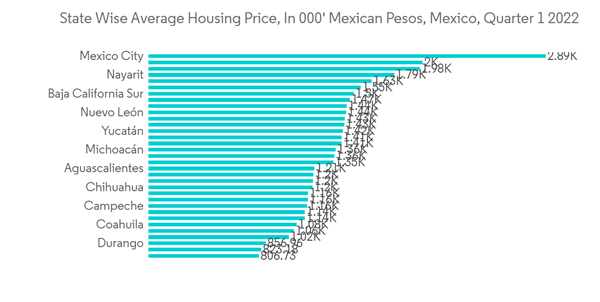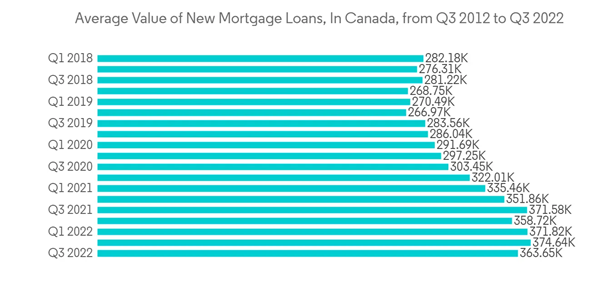Key Highlights
- Prior to the epidemic, there was already pent-up demand. It was false to say that millennials preferred renting over owning homes. Simply put, millennials lack the resources to own real estate. Some were affected by the Great Recession upon starting their careers; therefore, they did not have the savings of previous generations. Mortgages became less accessible as a result since banks were subject to tougher regulations and had to agree to lower down payments of at least 15-20%. Millennials were finally given the opportunity to buy homes, which boosted the already competitive market. Lockdown forced people to save, government stimulus programs improved their purchasing power, and steeply rising asset values The expectation of more remote employment and different COVID-19 constraints also contributed to significant migrant movements, which further fueled the purchasing frenzy. Strong investment in United States residential will drive industry spending through 2022.
- Cheap home supplies and historically low borrowing rates have boosted residential investment. In 2021, growth intensified as a result of increased home construction activity brought on by pent-up demand and improved vaccination rates among the populace. The demand for housing has also been supported by improvements in the labor economy. Despite this, the Federal Reserve has been forced to hike interest rates in 2022 due to growing inflation and worries of a recession. The time is now to update long-standing housing and urban planning rules and rebalance the supply and demand imbalance. The price of delay might be a severe social catastrophe brought on by a big, intergenerational group of people's discontent with their living circumstances, which would disproportionately affect younger generations.
North America Residential Construction Market Trends
800,000 Housing Units Must Be Built Annually in Mexico to Keep Up with Demand
In order to meet demand, Mexico will need to invest approximately 4% of its GDP annually in constructing 800,000 housing units over the next 20 years, which equals 3.87% of the country's GDP. While the number of individuals living together is declining, there is a growing demand for homes in Mexico. In Mexico, there were five people living in each home in 1990, which reached 3.6 per home in 2020. In the upcoming years, a lot of homes in Mexico will also need to be renovated. According to Mexico's national statistics office, 57% of homes were constructed by the owners, and many do not adhere to building rules.The real estate market in Los Cabos experienced its hottest year ever in 2021. With the number of single-family home sales increasing by 126% and the median price increasing by 49% year over year, it was a seller's market for the first time. Condo purchases increased by 192 percent, with a 19 percent increase in the median price number of single-family home sales increasing by 126% and the median price increasing by 49% year over year. It was a seller's market for the first time. Condo purchases increased by 192 percent, with a 19 percent increase in the median price. While growth accelerated outside the Los Cabos region, any backlog in pre-construction and pre-development inventory also rushed off the shelves. Demand for residential options increased significantly in Todos Santos, a hip surf town, as well as in La Paz, the capital of Baja Sur.
Canadian Home Buyers Have Been Rapidly Rising Canadian Mortgage Rates
Mortgage rates in Canada have been growing quickly as the country's inflation rate, which as of October 2021 was 6.9%, remained high. Inflation has been declining recently, partly as a result of the Bank of Canada's aggressive rate rises, but home prices have also been declining in the Canadian housing market. The New Housing Price Index (NHPI) for Canada fell on a monthly basis in October 2022 for the first time since November 2019. In November 2022, the same monthly drop persisted. The cost of borrowing will increase as mortgage rates continue to climb as a result of rate increases by the Bank of Canada and rising bond yields. The Bank of Canada raised interest rates by 0.50% in December 2022, pushing prime rates up to 6.45%, the highest level since early 2001. Continued rate increases will have an effect over the upcoming months.In the meantime, when the Federal Reserve accelerated its own aggressive rate-hike program in October, the USD/CAD exchange rate reached fresh highs. In July 2021, the CMHC (Canada Mortgage and Housing Corporation) reversed lending guidelines that had previously imposed limitations on mortgage insurance, including credit score requirements and debt service caps. This change made CMHC insurance more available, which facilitated borrowers' eligibility for a mortgage with CMHC insurance. In addition, it is now more difficult to get a mortgage due to a rise in the benchmark rate for the mortgage stress test that took effect on June 1, 2021. A decline in the affordability of their mortgage will be noticeable by potential homeowners when fixed-mortgage rates increase over 4.00% and the mortgage stress test rises above 5.25%.
North America Residential Construction Industry Overview
North America's housing construction market is highly fragmented, with no player having a significant share to influence the market. The market has many house manufacturers and service providers. The market presents opportunities for the growth of the companies during the forecast period, which is expected to further drive market competition. The market is expected to grow during the forecast period due to increased prefabricated housing construction investments, upcoming major projects in the country, and other factors. Major players are Lennar Corporation, D. R. Horton, PulteGroup, NVR, Mill Creek Residential, and Taylor Morrison.Additional Benefits:
- The market estimate (ME) sheet in Excel format
- 3 months of analyst support
This product will be delivered within 2 business days.
Table of Contents
Methodology

LOADING...










